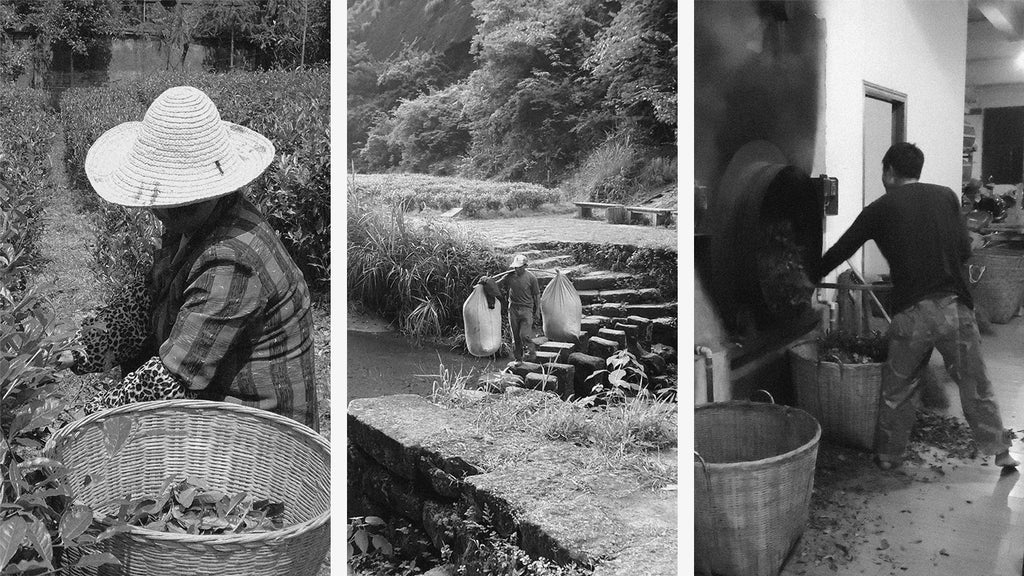
Our guide to oolong tea
share
4 min steep
Despite being a fabulous tea type, we brits haven’t fully explored the wonders of oolong. Even at Canton – a specialist high grade tea company – we sell much more black tea, green tea, blends and herbals. But we want to change that. Oolongs are the most diverse of all tea types, ranging in flavours from light, fruity and sweet to rich, dark and smoky. The broad spectrum of flavours is the result of oxidisation, with oolong being anywhere between 10-70% oxidised, and falling somewhere between a green and black tea. It’s also relatively easy to brew and lacks the astringency of green tea. As a result, oolongs are incredibly popular in traditional tea-drinking countries like China and Taiwan – who both produce some of the best oolongs in the world.
So, to help our customers understand a bit more about oolongs, we’ve put together a short guide. Once you try one, you’ll want to explore more.
History

|
Dragon Amid Clouds and Waves, Unidentified Artist, China, 15th-16th Century, The MET © |
Originating in China’s Wu Yi mountains in around the 15th Century, oolong gets its name from the Chinese for ‘Black Dragon’, some say it’s because of the shape of the dark twisted leaf, but the origin of the name is opaque. Growers discovered that by allowing the tea to oxidise, wonderful new flavours emerged from the leaf.
In Taiwan however, oolong cultivation was only developed during the 1860s by a Scottish merchant adventurer, John Dodd, who encouraged farmers to grow and trade in the tea. Today, Taiwan is a leading producer of fine oolongs. Since the 1970s the governments of both China and Taiwan have promoted and protected the production of quality oolongs. Oolong is now among the fastest growing categories in the fine tea market.
Growing and Production

|
Picking, transporting and processing leaves for Big Red Robe |
The major growing areas in China include Fujian, Wuyi, Anxi, Chao Zhou and other areas in the south west of the country. In Taiwan, Wenshan and Ali Shan traditionally produce the best oolongs. There are also some very interesting, experimental oolongs emerging from tea gardens around the world.
Once picked, the leaves are withered in the sun or indoors, depending on the climate of the growing region. Next they’re bruised, baked, and tumbled in heated drums or ovens to slow oxidation, then fired to stop it completely. The timing and intensity of these steps is what determines the flavour of a particular oolong tea.
Whether an oolong is rolled or twisted is a matter of style and tradition. Most rolled (or balled) oolongs are rolled by hand after they are 'fixed' to prevent further oxidisation. Darker, more heavily oxidised oolongs, such as Dan Cong or Da Hong Pao (Big Red Robe), tend to be twisted into strips, whereas lighter, greener oolongs, such as Tie Guan Yin and Ali Shan, are usually rolled (or balled).
Oolongs can be aged to improve the taste and are sometimes re-baked to awaken the flavours.
Health benefits of oolong

|
An oolong tea tasting ceremony in Fujian Province. |
Oolong tea is high in antioxidant polyphenols and research has shown that it may have other health benefits such as combating cholesterol and possibly helping with weight loss. The Chinese claim oolong is good for the heart, skin, and teeth. Other studies have shown that drinking oolong tea can help reduce high blood pressure and combat heart disease.
Oolong tea varieties

Big Red Robe (Da Hong Pao): Big Red Robe has a deep, intense all-encompassing flavour that envelops the mouth. This is a heavily oxidised oolong that is finished by roasting over charcoal. It’s produced in Wuyi, Fujian – and is one of the most approachable oolongs.
Iron Buddha (Tie Guan Yin): Tie Guan Yin, which is translated as The Iron Buddha or Iron Goddess of Mercy, is one of the most widespread and popular teas for everyday drinking in China (often enjoyed alongside dim sum). It is a rolled oolong from Anxi in Fujian Province with a sweet, floral liquor.
Honey Orchid (Mil Lan Dan Cong): Dan Congs are the champagne of oolongs and the higher grades can fetch fantastic prices. Honey Orchid Dan Cong is so called because it's made with the leaves of the Mi Lan Xiang cultivar tea bush (which directly translates as Honey Orchid aroma) – grown in the Phoenix Mountains of Guangdong. It’s roasted over charcoal after rolling and fixing, and produces a rich, orange-brown liquor that can explode on the palate with intense flavours of apricot and honey.
Jade Oolong: A Taiwanese rolled oolong from a rare tea bush varietal that thrives in low altitudes. Ours comes from Ming Jian village, where the bushes bask in the sunshine of the tropical landscape. It’s a complex oolong with a smooth, fruity flavour of ripe fruit, bamboo shoot and just a hint of lemon.


